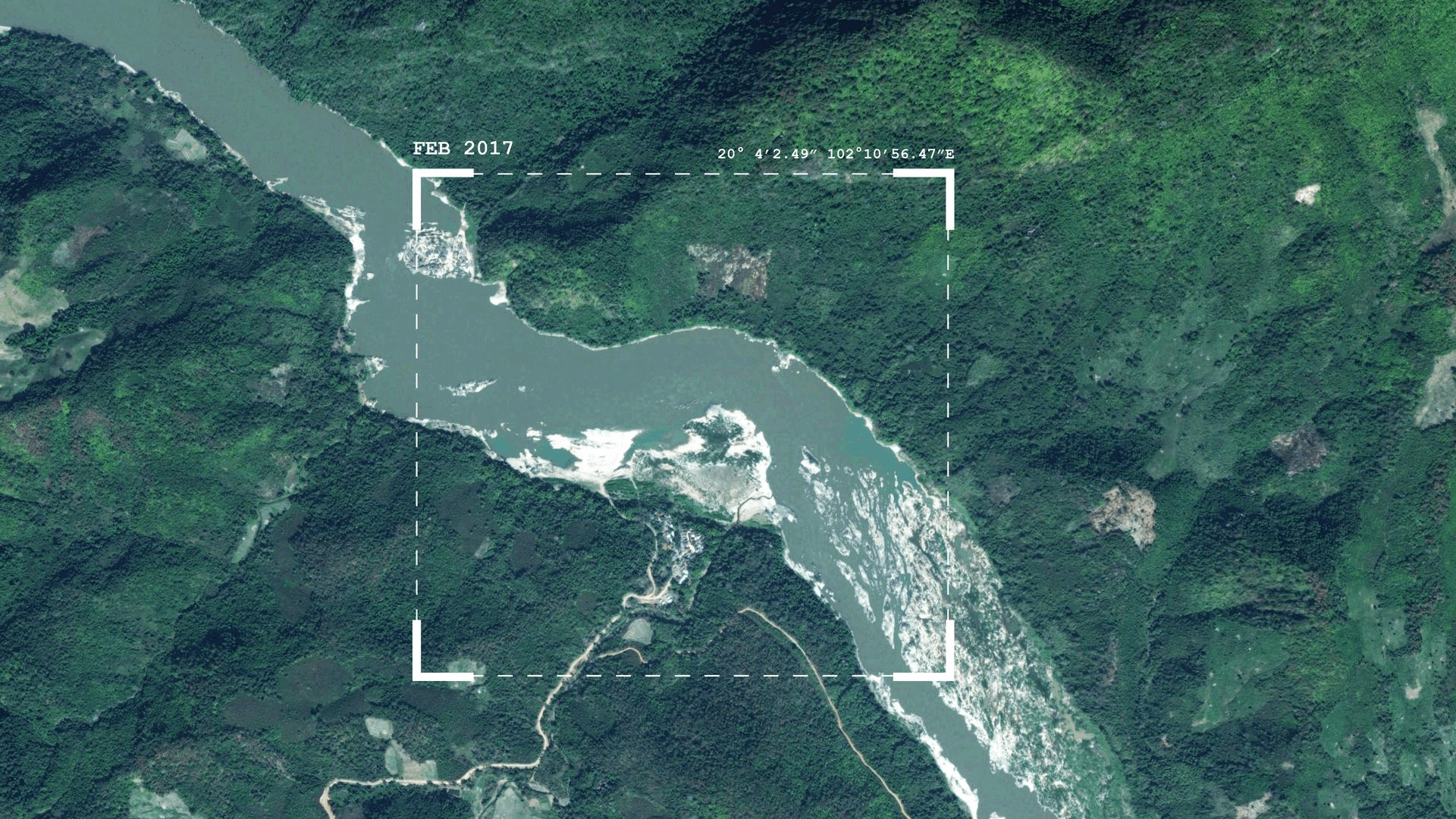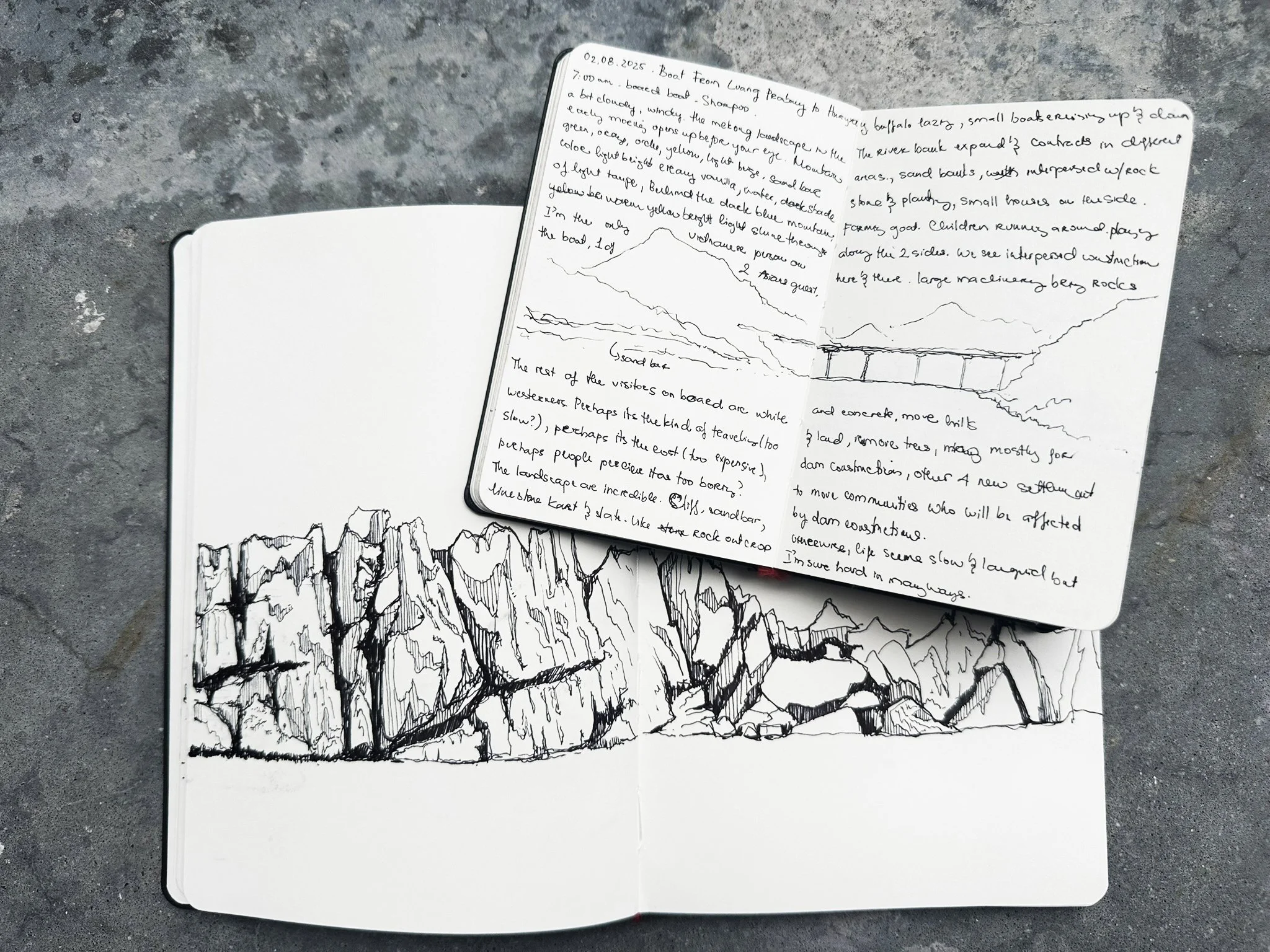
Post #9 Returning to the River
Back in Saigon now. The air feels different here--louder, faster, certainly more chaotic than upstream…
Before this year, I had just finished helping to construct a large climate-adaptive infrastructure project in New York, one of those enormous, technical, hopeful undertakings designed to meet the rising tides and biodiversity crisis head-on. (You can read more about that project [here].) When it was complete, I asked my office for a brief leave. I needed space to think, to return home, and to spend time in Southeast Asia. Not exactly for research, but simply to be near the people and the landscapes that formed me…

Post #8 – Between Borders
By the time we approach Houay Xay--the last stop on the two-day slow boat from Luang Prabang, the Mekong again becomes a border. On one side, Laos. On the other, Thailand. The same river, two nations, two flags fluttering over the same flow. (Further south, the Mekong River continues to mark the boundary between the two countries, from Ban Phalat to Phou Lau Seua.)
Andrew Alan Johnson writes of this liminal zone as a fecund space, where edges meet and blur, where people trade, marry, worship, and drift across invisible lines. Sitting on deck, I think about how Southeast Asia has always been such a space. For centuries, kingdoms here functioned as mandala states, their influence radiating outward from centers of power rather than being confined by fixed borders (Wolters, 1982). Things overlapped, mixed, brewed; and from those crossings, new forms emerged: languages, rituals, dances, architectures, cuisines, textiles... Hybridity in this region creates an alchemy of differences rather than sameness.

Post #7 - Reading Danube on the Mekong
Somewhere between Pak Beng and Houay Xay, I sat on the boat deck reading Claudio Magris’s Danube. It might feel strange, reading one river while traveling another. But both of these shared waters have carried stories, love, empires, faiths, migrations, life across their expansive reach. And both now bear the weight of infrastructure that promises progress while slowly undoing their souls and ecologies.
The Danube once possessed vast floodplains that are breeding grounds for sturgeon and pelican. These vital habitats have been largely lost to dams, levees, and navigation canals. Things are improving, especially since the establishment of International Commission for the Protection of the Danube River (ICPDR), where EU and non-EU states cooperate under binding conventions. The Mekong River Commission (MRC), by contrast, relies on voluntary coordination among competing national interests. Transparency, accountability, and downstream equity remain ever more fragile here.

Post #6 - Luang Prabang Dam
A bit further upstream, the quiet gives way. Barges grind past. A concrete wall juts out from a scraped hillside. Multiple cranes swing their arms, metallic insects busying themselves with heavy loads. Trucks thrum and kick up clouds of dust. The air is raw with the smell of earth moved. To shift a river is always a violent act.
This is the site of the Luang Prabang Dam, one of seven planned for the Mekong mainstream in Laos, in addition to the two already built at Xayaburi and Don Sahong. Laos imagines itself as the “Battery of Asia” by harnessing the river’s current for power export, even at the peril of the river and downstream neighbors. No one is blameless, though. Thailand is the largest customer of Lao’s hydropower. Vietnam and Cambodia also buy electricity and building their own dams on Mekong tributaries…

Post #5 - Naga, Buddha, Myths & Monsoon
The Naga on Alex’s chain glints—the river guardian, serpent of the in-between. Myth isn’t separate from the Mekong; it braids into the current like hyacinth roots.
The Naga is often depicted alongside the Buddha. Shortly after we left Luang Prabang, the boat stopped at the mouth of the Nam Ou. There one finds the Pak Ou Caves tucked into limestone cliffs. They hold hundreds of Buddha statues. I climbed the steep stair to the upper cave, where darkness pressed close and rows of Buddhas, many with their Naga’ protectors, glimmered in the half-light—standing, sitting, reclining, hands raised in blessing or pressed at the heart, a posture for every day of the week. The cave felt eerie and tender at once. Offerings and breath hung heavy in the cool air….

Post #4 - Klaus & The Drifting Rocks
Klaus, a Belgian in his seventies with the curiosity of three people, points at the various sized outcrops sticking out of the water. “Look,” he says, “the rock.” Slate-like plates. Dark blocks. Rounded river stones. Rose, rust, blue-black in color. By profession Klaus is an accountant, but his heart belongs to travel and photography. And to talking. Thankfully, he talks about the things I love listening to.
He tells of old seas, buried mountain bones, the Earth’s skin wrinkling, crust pushing, folding, cracking, lifting, until a river found the seams and ran its fingers through them. I love the grammar of it: grain, bedding, fracture, weathering. Outcrops rise like half-told stories, peeking through vanilla sand and ochre water. On them, horizontal water stains mark the ebb and swell of past seasons, a ledger written in stone…

Post #3 - Alex & The Shifting River
I met Alex, the tour owner, on the boat. He is French-Lao. His parents left Laos in the 1980s (or 70s?); he was born and raised in France but returned years later to make a life here. He wears a necklace with a golden Naga pendant, a keepsake from his grandfather.
The Naga is a mythic serpent, a water spirit, the guardian of rivers. In Lao (as in Khmer and Thai, especially Northern Thai) culture, Nagas are everywhere—in temple carvings, across textiles, on stair‐railings, in stories. They are the symbols of protection and fertility, of the river’s power, and its mystery.
Alex loves Laos the way people love a first language. As we floated, he spoke passionately about his worry for the dams on the Mekong, and about the flood of Chinese investments reshaping his country. Not for his business, he said, but for the land, the fish, the banks, the villages—everything that breathes from the water. Interrupt the flow and the whole ecology shifts: silt trapped, fish routes broken, forests cleared, families uprooted…

Post #2 - Ochre yellow water and cream vanilla sand
If you haven’t guessed already, these posts are written months after the trip—from a journal/sketchbook I kept along the way, and from the memories that return when I look back. They carry hindsight, reflection, and the weight of additional reading layered in after the fact.
Continuing on the slow boat in early February, 2025: we departed Luang Prabang early in the morning. The sun was up but hidden behind cloud, the air with a slight chill. The Mekong opened like a paintbox. Its colors were many, vibrant yet not aggressive—not the hot, overwhelming glare of Saigon summer. Mountain green. Orange-ochre cliffs. Sandbars in pale vanilla and light taupe. Behind them, teaks, banana trees, figs, and palms weaved a tapestry of green shades and stark beige bark. Further back, a dark blue ridge…

Post #1 - The Beginning - Slow Boat from Luang Prabang
I’ve been wanting to start this blog for a long time. Not sure why I’ve been hesitating. Maybe because it matters so much to me, and I wanted to shape it in the most beautiful, meaningful way possible. But that kind of waiting feels silly, just another form of perfectionist procrastination.
So I’ll start here.
In February this year, after visiting Luang Prabang with my uncle and my mother, I stepped onto a slow boat along the Mekong River. It felt like a pilgrimage. A journey I had been carrying in me for years, maybe a decade or more, ever since I first read about the 19th century Mekong Expedition led by Ernest Doudard de Lagrée, Francis Garnier, and their crew…
